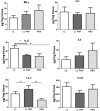Oral delivery of pancreatitis-associated protein by Lactococcus lactis displays protective effects in dinitro-benzenesulfonic-acid-induced colitis model and is able to modulate the composition of the microbiota
- PMID: 31325218
- PMCID: PMC6899824
- DOI: 10.1111/1462-2920.14748
Oral delivery of pancreatitis-associated protein by Lactococcus lactis displays protective effects in dinitro-benzenesulfonic-acid-induced colitis model and is able to modulate the composition of the microbiota
Abstract
Antimicrobial peptides secreted by intestinal immune and epithelial cells are important effectors of innate immunity. They play an essential role in the maintenance of intestinal homeostasis by limiting microbial epithelium interactions and preventing unnecessary microbe-driven inflammation. Pancreatitis-associated protein (PAP) belongs to Regenerating islet-derived III proteins family and is a C-type (Ca+2 dependent) lectin. PAP protein plays a protective effect presenting anti-inflammatory properties able to reduce the severity of colitis, preserving gut barrier and epithelial inflammation. Here, we sought to determine whether PAP delivered at intestinal lumen by recombinant Lactococcus lactis strain (LL-PAP) before and after chemically induced colitis is able to reduce the severity in two models of colitis. After construction and characterization of our recombinant strains, we tested their effects in dinitro-benzenesulfonic-acid (DNBS) and Dextran sulfate sodium (DSS) colitis model. After the DNBS challenge, mice treated with LL-PAP presented less severe colitis compared with PBS and LL-empty-treated mice groups. After the DSS challenge, no protective effects of LL-PAP could be detected. We determined that after 5 days administration, LL-PAP increase butyrate producer's bacteria, especially Eubacterium plexicaudatum. Based on our findings, we hypothesize that a treatment with LL-PAP shifts the microbiota preventing the severity of colon inflammation in DNBS colitis model. These protective roles of LL-PAP in DNBS colitis model might be through intestinal microbiota modulation.
© 2019 The Authors. Environmental Microbiology published by Society for Applied Microbiology and John Wiley & Sons Ltd.
Figures








Similar articles
-
Enteric Delivery of Regenerating Family Member 3 alpha Alters the Intestinal Microbiota and Controls Inflammation in Mice With Colitis.Gastroenterology. 2018 Mar;154(4):1009-1023.e14. doi: 10.1053/j.gastro.2017.11.003. Epub 2017 Nov 11. Gastroenterology. 2018. PMID: 29133078
-
Secretion of biologically active pancreatitis-associated protein I (PAP) by genetically modified dairy Lactococcus lactis NZ9000 in the prevention of intestinal mucositis.Microb Cell Fact. 2017 Feb 13;16(1):27. doi: 10.1186/s12934-017-0624-x. Microb Cell Fact. 2017. PMID: 28193209 Free PMC article.
-
Oral delivery of a Lactococcus lactis strain secreting bovine lactoferricin-lactoferrampin alleviates the development of acute colitis in mice.Appl Microbiol Biotechnol. 2019 Aug;103(15):6169-6186. doi: 10.1007/s00253-019-09898-6. Epub 2019 Jun 4. Appl Microbiol Biotechnol. 2019. PMID: 31165225
-
Protective effect of TSLP delivered at the gut mucosa level by recombinant lactic acid bacteria in DSS-induced colitis mouse model.Microb Cell Fact. 2015 Nov 6;14:176. doi: 10.1186/s12934-015-0367-5. Microb Cell Fact. 2015. PMID: 26546058 Free PMC article.
-
Intestinal barrier, immunity and gut microbiota-based protective effects of Lactococcus lactis HF08 and its postbiotic derivative on aging and aging colitis mice.Food Res Int. 2024 Dec;197(Pt 1):115164. doi: 10.1016/j.foodres.2024.115164. Epub 2024 Oct 9. Food Res Int. 2024. PMID: 39593375
Cited by
-
Strategy of Developing Oral Vaccine Candidates Against Co-infection of Porcine Diarrhea Viruses Based on a Lactobacillus Delivery System.Front Microbiol. 2022 Apr 4;13:872550. doi: 10.3389/fmicb.2022.872550. eCollection 2022. Front Microbiol. 2022. PMID: 35444630 Free PMC article.
-
AhR Activation Transcriptionally Induces Anti-Microbial Peptide Alpha-Defensin 1 Leading to Reversal of Gut Microbiota Dysbiosis and Colitis.Gut Microbes. 2025 Dec;17(1):2460538. doi: 10.1080/19490976.2025.2460538. Epub 2025 Feb 2. Gut Microbes. 2025. PMID: 39894796 Free PMC article.
-
Fecal acute phase proteins in cats with chronic enteropathies.J Vet Intern Med. 2023 Sep-Oct;37(5):1750-1759. doi: 10.1111/jvim.16802. Epub 2023 Jul 4. J Vet Intern Med. 2023. PMID: 37401847 Free PMC article.
-
Lactococcus lactis engineered to deliver hCAP18 cDNA alleviates DNBS-induced colitis in C57BL/6 mice by promoting IL17A and IL10 cytokine expression.Sci Rep. 2022 Sep 19;12(1):15641. doi: 10.1038/s41598-022-19455-3. Sci Rep. 2022. PMID: 36123355 Free PMC article.
-
Recent advances in bacteria-based platforms for inflammatory bowel diseases treatment.Exploration (Beijing). 2024 Mar 5;4(5):20230142. doi: 10.1002/EXP.20230142. eCollection 2024 Oct. Exploration (Beijing). 2024. PMID: 39439496 Free PMC article. Review.
References
-
- Adel‐Patient, K. , Ah‐Leung, S. , Creminon, C. , Nouaille, S. , Chatel, J.M. , Langella, P. , and Wal, J.M. (2005) Oral administration of recombinant Lactococcus lactis expressing bovine beta‐lactoglobulin partially prevents mice from sensitization. Clin Exp Allergy 35: 539–546. - PubMed
-
- Atarashi, K. , Tanoue, T. , Oshima, K. , Suda, W. , Nagano, Y. , Nishikawa, H. , et al (2013) Treg induction by a rationally selected mixture of clostridia strains from the human microbiota. Nature 500: 232–236. - PubMed
Publication types
MeSH terms
Substances
Grants and funding
LinkOut - more resources
Full Text Sources
Research Materials

